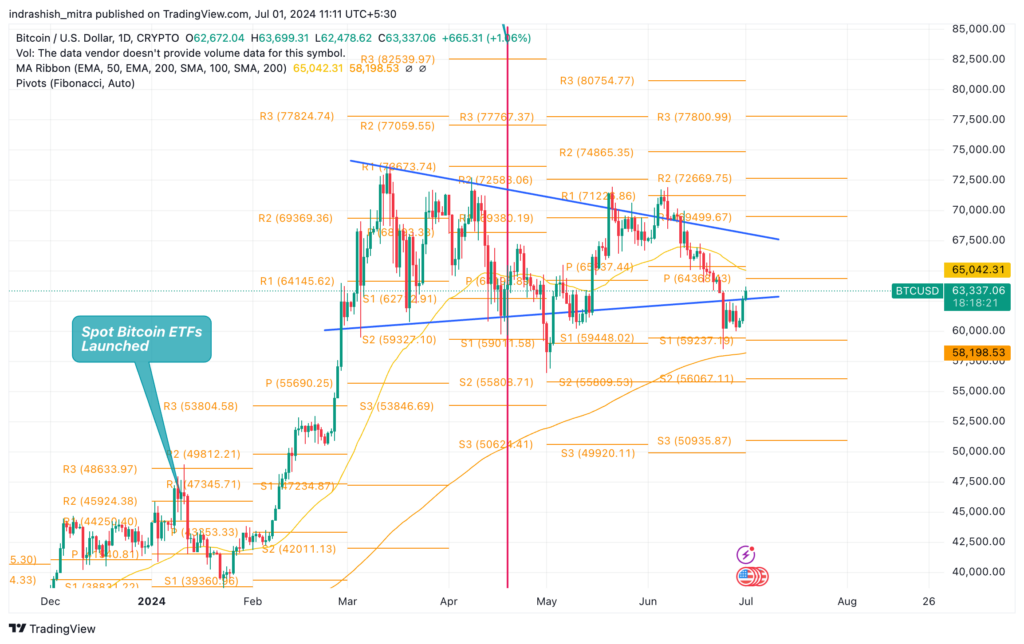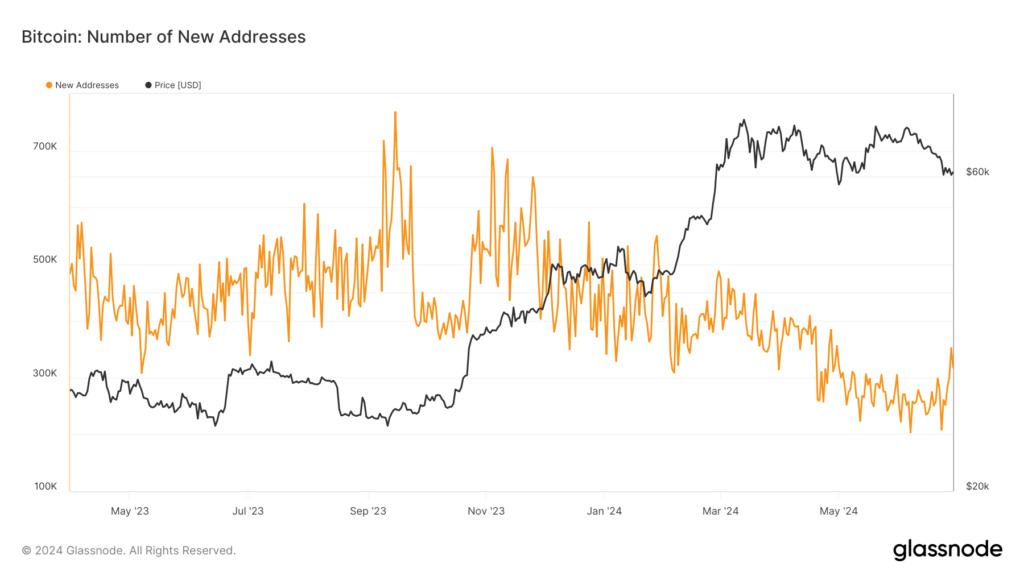Table of Contents
ToggleKey Takeaways:
- Bitcoin Price Fluctuations: Bitcoin price dropped below $60,000 twice in a week but has since rebounded to over $63,000, demonstrating significant volatility in the market.
- Increased Exchange Reserves: The volume of Bitcoin held on exchanges increased by approximately 14,000 BTC, indicating potential selling pressure or enhanced liquidity, influencing trading dynamics.
- Surge in New Bitcoin Addresses: The creation of new Bitcoin addresses surged to over 350,000 daily, the highest in nearly three months, suggesting renewed interest and participation in the Bitcoin market.
- Bearish Momentum Indicated by RSI: Bitcoin price’s Relative Strength Index (RSI) was around 38, signaling strong bearish momentum, yet a potential rebound is possible if the RSI approaches oversold conditions.
- Market Dynamics and Future Outlook: The recent BTC price movements, coupled with on-chain growth and changes in exchange reserves, highlight the complex interplay of market forces, suggesting cautious optimism for future Bitcoin price trends.
Bitcoin price volatility has been a hot topic among crypto enthusiasts and investors, especially after the recent fluctuations that saw BTC price dip below the $60,000 mark twice in one week. Despite these dips, Bitcoin price has shown resilience and is currently trading back above $63,000. This article explores the factors influencing these price movements, including new address creation, exchange reserves, and market sentiment.
Read More: Bitcoin Price Prediction
Bitcoin Price Dips Below $60,000
Bitcoin price has maintained a significant price range, staying around the $60,000 mark for the most part. However, the past week saw BTC price drop below $60,000 on two occasions, accompanied by a slight increase in the reserves held by exchanges.
On June 24, Bitcoin price experienced a significant drop of 4.60%, with the day’s trading closing at approximately $60,263 after hitting a low of $58,411. A few days later, on June 28, BTC price again tested lower levels, declining to $59,868 and closing at around $60,313, marking a decline of over 2%.
Despite these drops, Bitcoin price has managed to recover, and as of writing, BTC price is trading at around $63,000. The Relative Strength Index (RSI), a key indicator of price momentum, was around 38 during the decline, suggesting strong bearish momentum. Typically, an RSI below 40 indicates bearish momentum, and values approaching 30 signal an oversold condition, which might precede a price rebound.
Impact on Market Dynamics
This week’s Bitcoin price movements have significantly impacted broader market dynamics, including the creation of new Bitcoin addresses and changes in exchange reserves. Typically, significant price declines trigger increased activity on exchanges as traders move BTC to sell or buy at perceived key levels. Additionally, new addresses may be created as new or existing participants enter the market to capitalize on the volatility.
Increase in Bitcoin on Exchanges
Data from CryptoQuant revealed a subtle yet noteworthy uptick in the volume of Bitcoin held on exchanges. While the exchange reserve generally stayed around the 2.8 million BTC range, there have been minor fluctuations. Recently, the reserve has increased by approximately 14,000 BTC, translating to an influx of about $851 million worth of BTC to exchanges. As of this writing, the total BTC held in exchange reserves was around 2.841 million BTC.
This increment in exchange reserves could have several implications. Typically, an increase in Bitcoin on exchanges is interpreted as a potential preparation for selling, which might exert downward pressure on prices. Alternatively, it can also indicate greater liquidity, potentially leading to increased trading volume.
Know More: Is Bitcoin Bull Run Coming Soon?
Surge in New Bitcoin Addresses
For the first time in nearly three months, there has been a notable increase in the creation of daily new Bitcoin addresses. According to Glassnode, the number of daily new addresses surged to over 350,000. This level of activity had not been observed since April.
This spike in new addresses could signify renewed interest in Bitcoin, potentially from new entrants to the market or existing participants establishing additional addresses. Such a significant rise often reflects broader market movements or sentiment shifts, which could have various implications for BTC’s network activity and price dynamics.
What’s Next for Bitcoin?
Despite the recent dips, Bitcoin’s resilience suggests potential for further upward movement. The current trading price above $63,000 indicates a recovery from the lows experienced last week. Key levels to watch include $63,000 as immediate support, with significant resistance between $64,000 and $65,000.
Optimism remains high among investors, driven by factors such as the anticipation surrounding Bitcoin’s halving and new institutional interest. Moreover, the increase in new addresses and exchange reserves points to heightened market activity.
Conclusion
Bitcoin’s recent price movements below $60,000, followed by a recovery to above $63,000, highlight the crypto’s volatility and resilience. The increase in exchange reserves and new address creation suggests significant market activity and interest. As Bitcoin navigates these fluctuations, investors and traders should remain vigilant, monitoring key levels and market dynamics for potential opportunities.
With Bitcoin price back above $63,000, the focus now shifts to maintaining this momentum and navigating the ever-evolving crypto market landscape. Whether this recent recovery signals a new bullish phase or further volatility remains to be seen, but the data suggests that Bitcoin’s journey is far from over.
Source: AMBCrypto
Related posts
Bitcoin Price Hits New All-Time High Following Fed’s 25-Basis-Point Rate Cut
Fed’s interest rate cut spurs crypto momentum, boosting Bitcoin and Ethereum prices.
Read more
Blum Secures Major Investment from TOP to Strengthen DeFi Presence in TON Ecosystem
TOP’s backing aims to accelerate Blum’s multi-blockchain expansion.
Read more




